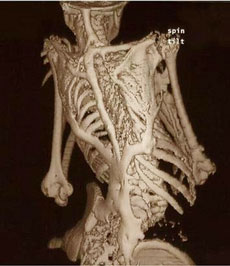NEW YORK - Scientists have discovered a mutant gene that triggers the body to
form a second, renegade skeleton, solving the mystery of a rare disease called
FOP that imprisons children in bone for life.

In this handout photo
provided by the University of Pennsylvania, a CAT scan showing the back of
an unnamed 12-year-old patient of Dr. Frederick Kaplan, showing bone
formation typical of FOP, is shown. Scientists have discovered a mutant
gene that triggers the body to form a second, renegade skeleton, solving
the mystery of a rare disease called FOP that imprisons children in bone
for life. [AP] |
The finding, reported Sunday,
may one day lead to development of a drug, not only to treat the rare bone
disorder, but more common bone buildup related to head and spine trauma, and
even sports injuries, the researchers said.
"We've reached the summit," said Dr. Frederick Kaplan, an orthopedist whose
team at the University of Pennsylvania School of Medicine pinpointed the cause
of FOP, or fibrodysplasia ossificans progressiva. The disease is believed to
afflict only 2,500 people worldwide.
The research was reported in the online edition of the journal Nature
Genetics by Kaplan, geneticist Eileen M. Shore, and their Penn colleagues, with
contributions from researchers in Australia, Brazil, France, Germany, Great
Britain, the Netherlands and South Korea.
After 15 years of work involving study of the genetic makeup of
multigenerational families around the world, scientists at Penn's Center for
Research in FOP and Related Disorders found that FOP is caused by a single
mutation in a gene called ACVR1. This devastating glitch means that tendons,
ligaments and skeletal muscle begin painfully transforming into bone, sometimes
locking joints overnight.
The genetic twist that leads to FOP, Kaplan said in a telephone interview,
"is relevant to every condition that affects the formation of bone and every
condition that affects the formation of the skeleton."
The researchers believe it should be possible to develop a drug that would
block or bypass the genetic trigger of the extra bone growth. Eventually, it
might block the unneeded bone that occasionally forms after hip-replacement
surgery.
"In the next five years, this might open up the possibility of developing
drugs that would be effective in stopping bone formation," said Dr. Victor A.
McKusick, a genetics pioneer and professor of medical genetics at Johns Hopkins
University School of Medicine in Baltimore.
He said the FOP genetic breakthrough is likely to shed light on other related
diseases.
"The first thing that comes to mind is osteoporosis, which is the flip side
of the coin when it comes to bone formation," he said. "When one learns about
one side ¡ª extra bone growth ¡ª it helps you understand what goes the other way"
¡ª bone breakdown.
Stephanie Snow, a 15-year-old with FOP, hopes the finding will lead to a drug
that can stop the stiffening damage to her body, which includes a fused,
immobile neck, arms she can't raise and problems with hip mobility. The Santa
Maria, Calif. teenager dreams of becoming a veterinarian.
"If they develop a pill we can take every day, I can move and do more things,
and it might be easier for me to become a vet, like I've always wanted to," she
said.
FOP patient Jeannie Peeper, 47, of Winter Springs, Fla., is totally
immobilized but still a leader in the International FOP Association that
represents patients and their families.
"The gene discovery is an extraordinary gift to the FOP community and a
monumental milestone on our road to a cure," she said.